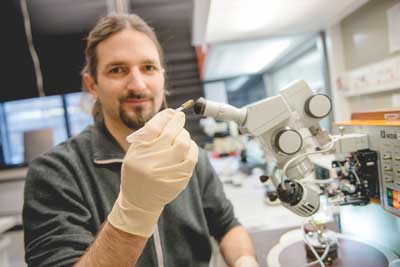| Posted: Jan 24, 2018 |
Researchers achieve microscope resolutions in the 30 nanometer range
(Nanowerk News) Objects smaller than half the wavelength of the utilised light cannot be viewed with the aid of traditional light microscopes. A research team from Ruhr-Universität Bochum (RUB) and the University of Basel has succeeded in enhancing the resolution for microscopic analysis of solid state systems to 1/31 of the wavelength of the utilised light. To this end, the researchers used quantum dots which they embedded in semiconductors. Deploying a specific laser pulse, the electrons contained therein can be “turned on and off”. The results were published in Nature Photonics ("Far-field nanoscopy on a semiconductor quantum dot via a rapid-adiabatic-passage-based switch").
|
 |
| The quantum dots were developed by Arne Ludwig and his collegues in Bochum. (Image: Ruhr-Universität-Bochum)
|
The limits of light microscopy
|
|
Light microscopy can render miniscule structures visible, but only up to a certain limit: if the dimensions of the viewed objects are only the size of half the wavelength of the light, diffraction phenomena begin to interfere. Objects that are less than several 100 nanometres apart can no longer be represented separately. The image becomes fuzzy, the objects blur.
|
|
Near-field scanning optical microscopy bypasses this problem by utilising the scattered light of a very small object at a surface for imaging. However, if the viewed object is not located near a surface, but is embedded inside a solid object instead, microscopic analyses have been subject to the limits mentioned above.
|
Nobel Prize for bypassing the resolution limit
|
|
Göttingen-based researcher Stefan Hell was the first to bypass this so-called Abbe diffraction limit, which gained him the Nobel Prize for Chemistry in 2014. He used several laser pulses and fluorescent molecules that can be switched on and off. It was thus possible to achieve a resolution of object details of biological samples that was ten times better than hitherto.
|
|
First author of the study Dr. Timo Kaldewey in the team headed by Prof Dr Richard Warburton from the University of Basel and Dr Arne Ludwig, Sascha Valentin and Prof Dr Andreas Wieck from the Chair for Applied Solid State Physics at RUB have now successfully translated this principle to a solid state system with artificial atoms, so-called quantum dots. Quantum dots are semiconductor particles that are only approx. ten nanometres in size, in which single electrons can be confined. Due to their small dimensions, those electrons can only assume specific energy levels – similar to atoms where electrons are arranged in specific shells.
|
Chirped laser
|
|
In case of Stefan Hell’s fluorescent molecules, it was necessary to switch the molecules in a long-lasting metastable dark state. “We, however, avoided this on purpose by analysing a short state in the quantum dots that lasted only one nanosecond,” explains Arne Ludwig. For this purpose, it was necessary to develop an optical switch that controls artificial atoms on the quantum level. The researchers utilised so-called chirped laser pulses, namely short pulses with changing frequency – similar to the chirping of birds, but on a time scale that is approx. a hundred billion times shorter.
|
|
Thus, they were able to initiate a so-called rapid adiabatic passage, i.e. a tool for inverting the energy level of electrons in quantum dots in a controlled manner. As a result, they had a control switch on the quantum level at their disposal. The resolution thus attained equalled 1/31 of the wavelength of the utilised light.
|
Embedding dots in a crystal
|
|
The quantum dots were developed by Sascha Valentin and Arne Ludwig in Andreas Wieck’s group in Bochum. To this end, the dots had to be embedded in a special crystal matrix to ensure that individual photons were available for microscopy at a sufficiently high rate.
|
|
“With this new technique we have developed a method for applying quantum switches – even without metastable states – in microscopy,” says Richard Warburton. “This takes Stefan Hell’s microscopy approach to the next level. It is thus possible to conduct nanoscale analyses for almost every quantum system.”
|
|
Moreover, the new switch is just that: a control element on the nano level and, therefore, a crucial milestone towards utilising artificial atoms as quantum information units.
|

